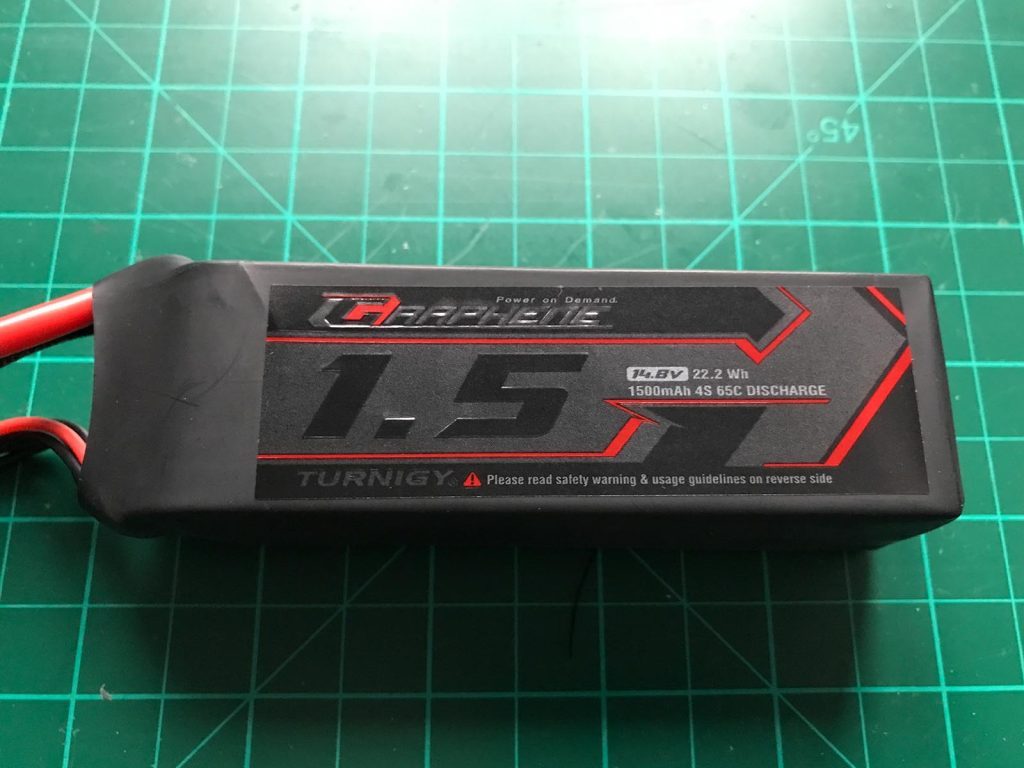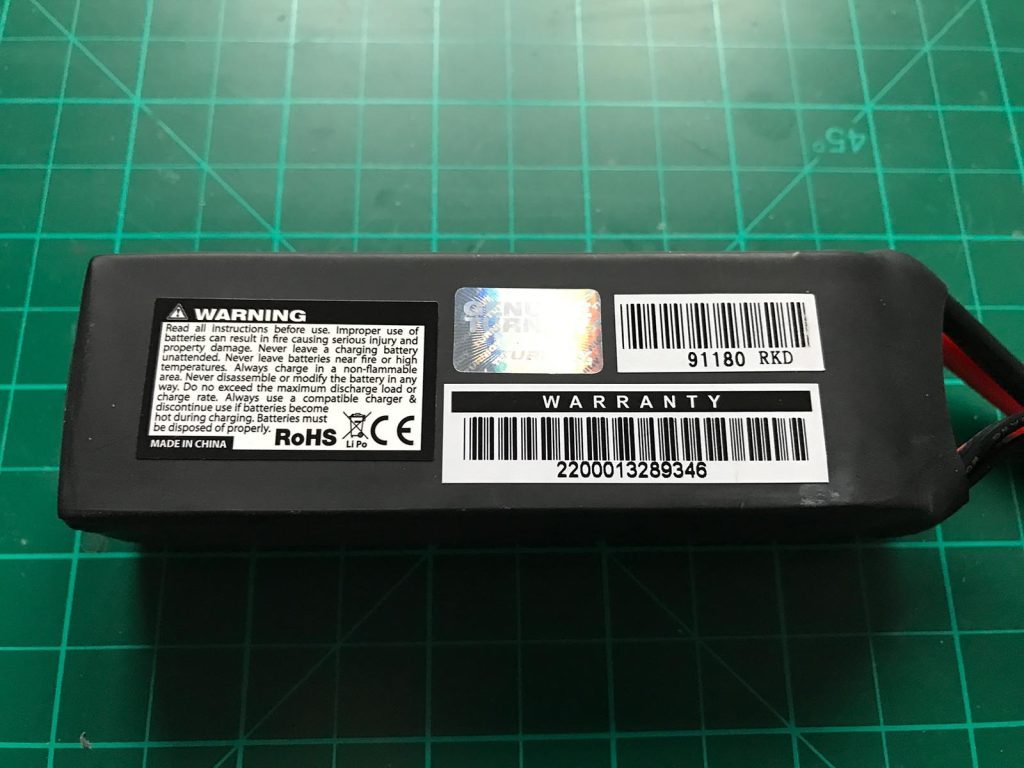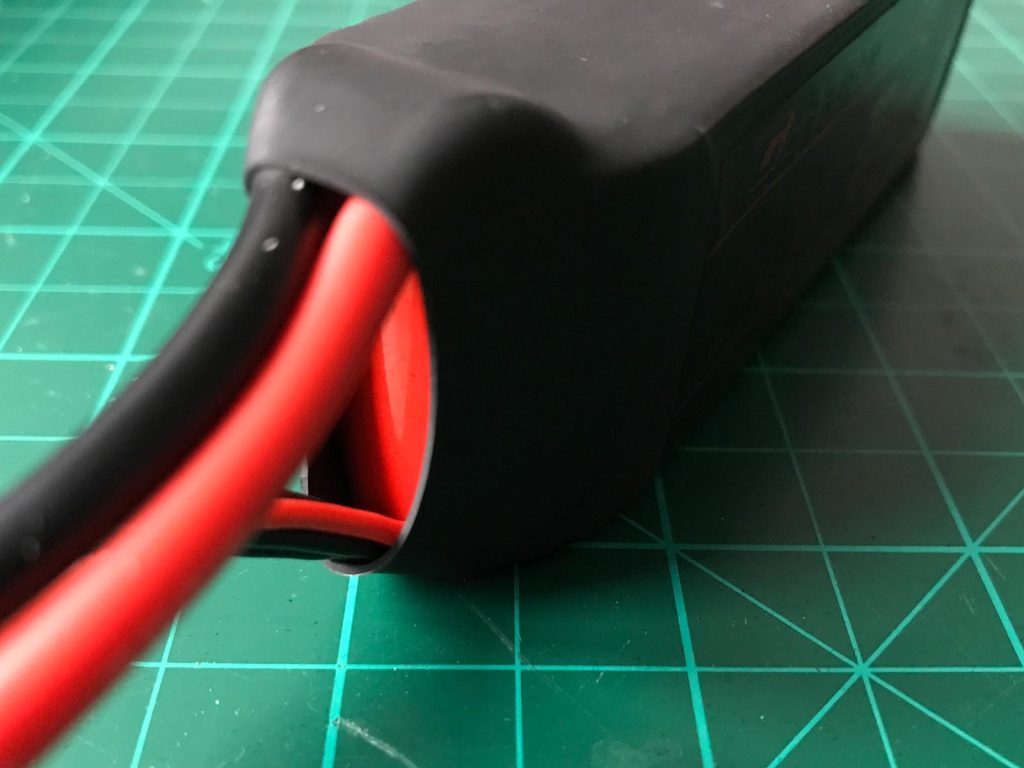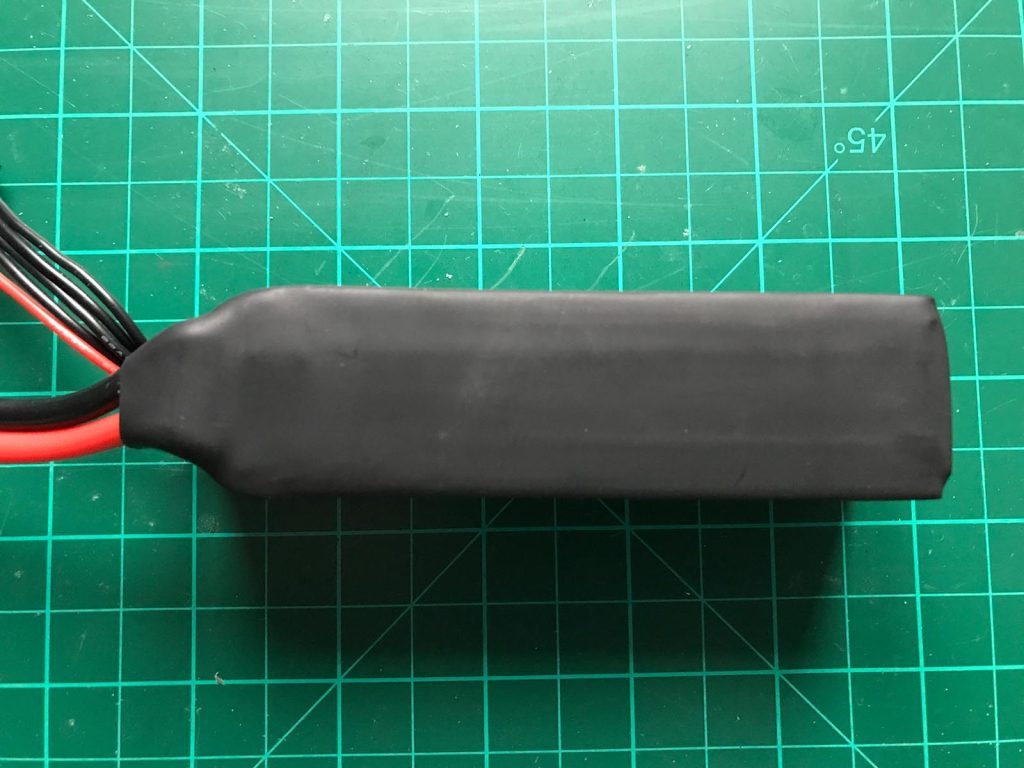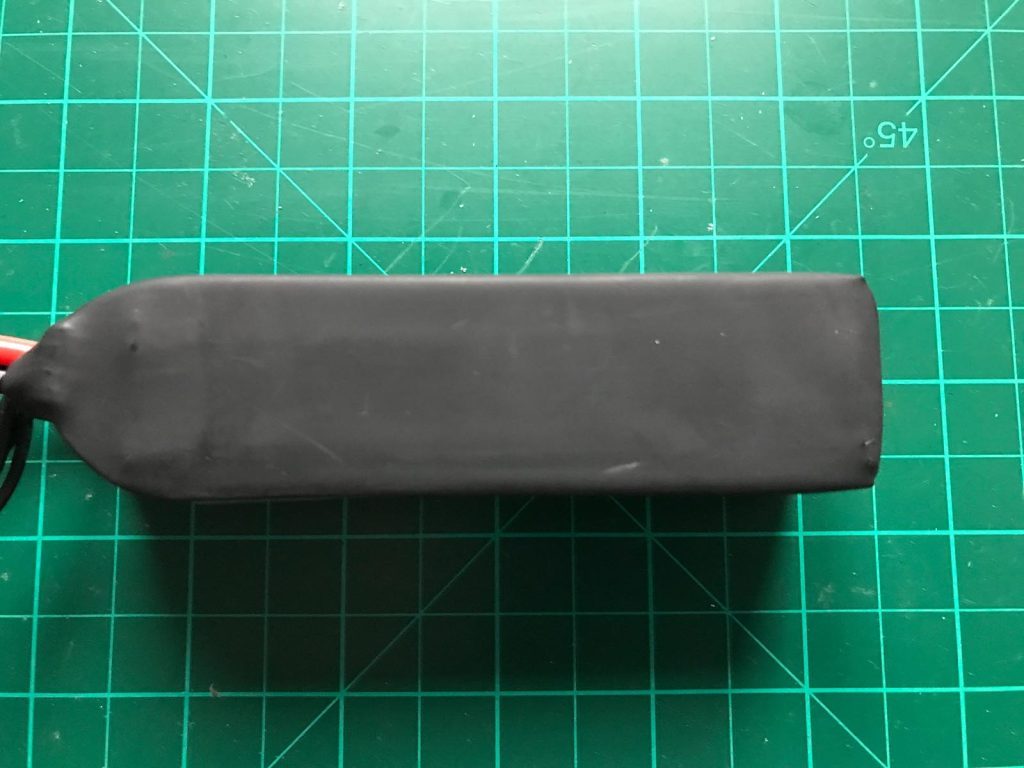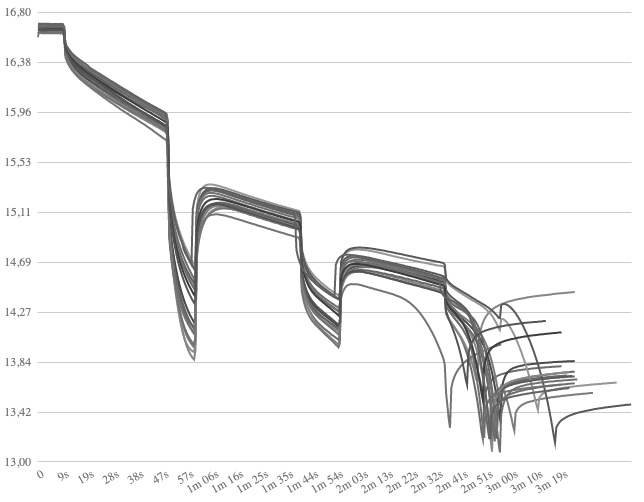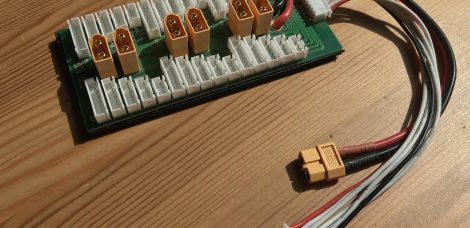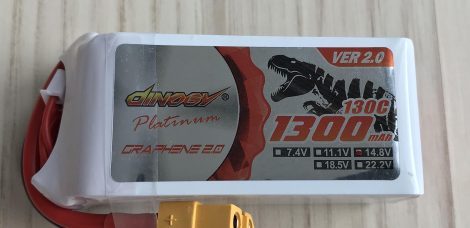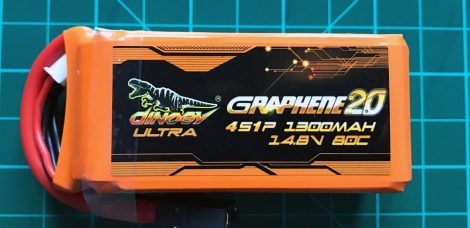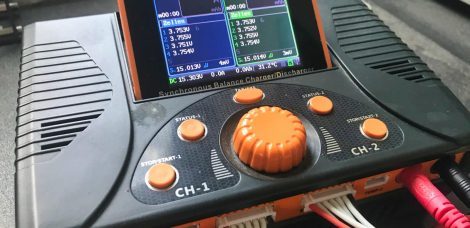After almost a year of battery testing I finally was able to get my hands on some samples of the all mighty Turnigy Graphene battery pack. This review covers the Turnigy Graphene 4S 1500 mAh 65 C version.
Appearance
HobbyKing* (the company behind the Turnigy battery lineup) has been in the game for a long time. After the first Turnigy Graphene packs showed up, the FPV scene went nuts, impressed by the „power“ the packs offered compared to normal lithium polymer packs by that time. We are going to take a closer look and compare the performance with competitor products.
The Turnigy Graphene 1500 mAh 65 C* battery comes in a high-quality card board box with a lot of protective foam inside. The actual battery is once more packed within a handy fabric bag (like the one that comes with your Dominator googles). The battery itself is covered in matte black shrink wrapping.
Stickers on front and pack give you the usual information, how to use the battery. The sides are composed of some red plastic, which will protect the cells from punctures on impact. The overall design underlines the impression of a high quality product.
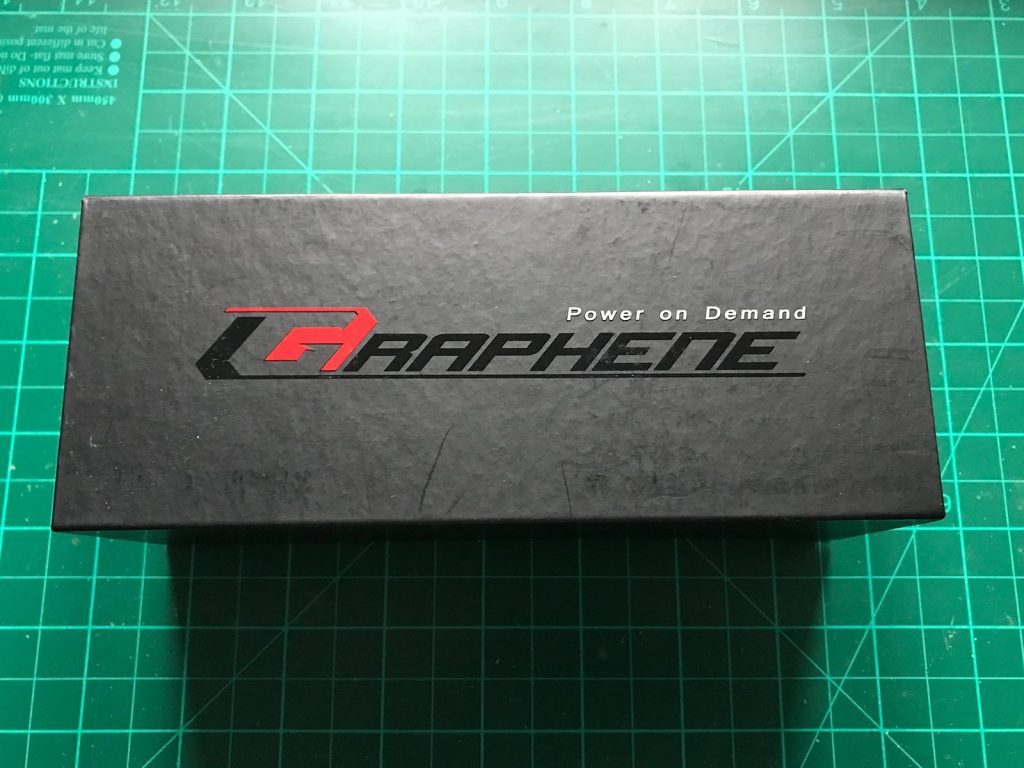
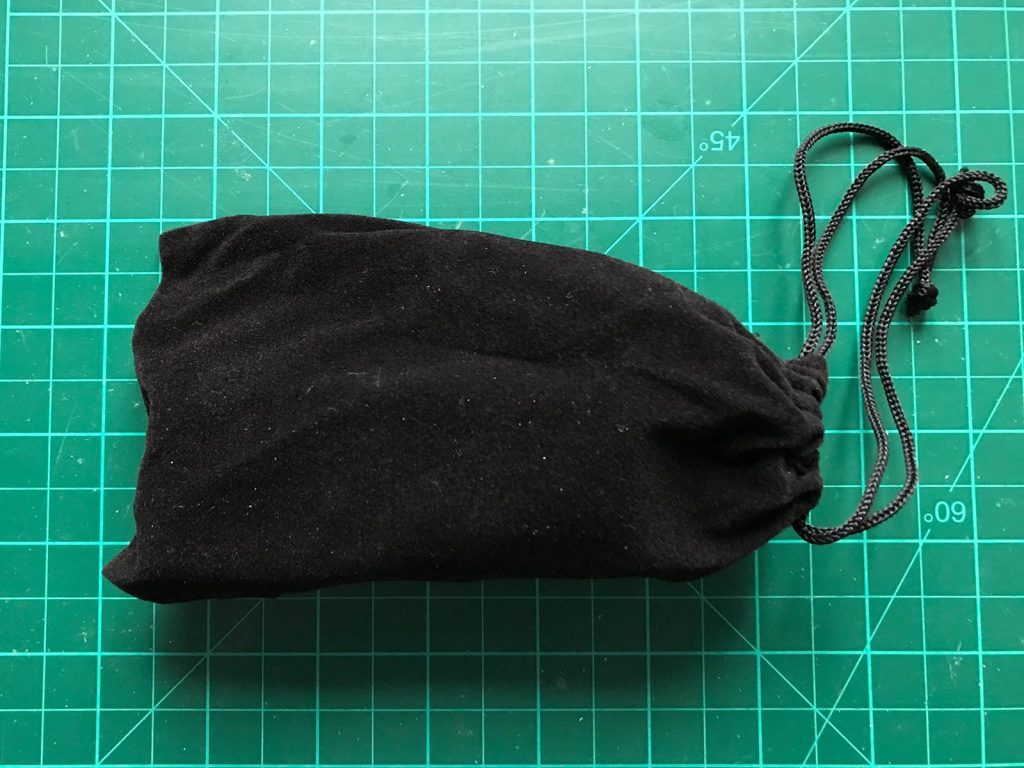
Technical Design
The Turnigy Graphene 65 C pack* is a standard 4S1P config flight pack for high power use. As the product name suggests the battery uses graphene-enabled chemistry to lower internal resistance (hence improve voltage stability under high loads) and heat generation. The Turnigy Graphene line-up has been the first graphene-enabled LiPo battery widely available. This makes it especially interesting to compare with other high performance flight packs.
Build Quality: Very good. Pack feels very well made on the outside. Connection terminal looks solid. A small layer of foam offers protection on the sides. The red coloring looks cool.
Plugs: The Turnigy pack comes with standard black XT60 connectors* equipped .
Cables: HK uses 12 AWG wires on this packs. The high flexible silicon layer is rated up to 200°C. Cable length is about 9 centimeters, which is quiet long.
Balacing plugs: Standard XT-system*. Balance wires are long (7 cm) which can be a challenge to deal with on smaller quads. Main power line and balancer wires are connected to the top and bottom of the pack.
Buy Turnigy Batteries on Amazon!*
Technical Details
| Manufacturer | Turnigy (HobbyKing)* |
| Type | Turnigy Graphene 65 C |
| Cell chemistry | Lithium Polymere (LiPo) |
| Cell type | Turnigy Graphene |
| Cell count | 4 |
| Pack configuration | 4S1P |
| Capacity | 1500 mAh |
| Max. Charge Current | 15 A |
| Max. Discharge Current Continuous Burst | 97.5 A 195 A |
| Weight w/o plugs with plugs | - ca. 209 grams |
| Measurements as listed measured | 35 x 30 x 107 mm 35 x 30 x 115 mm |
| Price | Check price on Amazon* |
| Dealer | |
| Note | This battery has been donated for review purposes, but was shipped from the HK EU warehouse as an usual customer order. |
Impressions
Break-in documentation
The battery followed the standard break-in-process: The pack is charged at a rate of 1C until CV-phase ends with current of 1/10C. The break-in phase consists of four charging cycles at 1C and four corresponding discharges at 1 C / 4C / 10C and 20 C.
Anomalies: No anomalies during break-in.
Internal resistance measurements during break-in phase
| Cycle | Cell 1 | Cell 2 | Cell 3 | Cell 4 | Total |
| After first charge | 1.4 mΩ | 1.6 mΩ | 1.6 mΩ | 1.5 mΩ | 6.1 mΩ |
| After second charge | 2.0 mΩ | 2.0 mΩ | 1.0 mΩ | 1.8 mΩ | 6.8 mΩ |
| After third charge | 1.3 mΩ | 1.4 mΩ | 1.7 mΩ | 1.3 mΩ | 5.7 mΩ |
| After fourth charge | 1.8 mΩ | 1.3 mΩ | 2.1 mΩ | 1.0 mΩ | 6.2 mΩ |
Charging process
CV-Phase is very short on this cell type. Balancing in normal mode took 1:01 min. Cell drift during charge was unobtrusive. This is for 1C charge (1,5 A).
Load Testing
The main part of this battery test will consists of different load test settings showing the battery performance. Constant load testing is used to judge the advertised C-ratings as well as look at cell drift under high loads. We also check on internal resistance once more. Next up is the dynamic current test, which simulates a „real“ flight with changing (=dynamic) loads. For test methodology please check the dedicated methodology page!
Constant Load Testing
Constant load testing follows a certain load pattern of different constant currents. Base load is 10 C. Current pulses at 50 C, 35 C, 20 C and 30 C are maintained for time intervals between 10 and 20 seconds. For more details please refer to the test methodology page.
Capacity Usage
During this test the pack delivered 1121 mAh. This is 74,7 % of nominal capacity. A solid good result.
Average cell voltages
The following table lists the average voltages per cell, of the total pack, as well as the averaged value per cell as fraction of total voltage during phase of active load.
| Cell 1 | Cell 2 | Cell 3 | Cell 4 | Total | Average per cell | |
| Avg. Voltages | 3.773 V | 3.773 V | 3.777 V | 3.777 V | 15.099 V | 3.775 V |
Just looking at average values the Turnigy Graphene pack* performs good. All cells stayed well above 3,7 V on average. An average value above 3,74 V / cell can be considered very good.
Focus Voltages
Exceptionally interesting when testing a battery under a constant load for a longer period of time: the lowest voltage per cell just before load impulse is disabled. On top, you should have look at voltage recovery rate, that is: how fast do cell voltages rise again once load impulse is cut.
| Phase | Cell 1 | Cell 2 | Cell 3 | Cell 4 | Total |
| End of 50 C | 3.654 V | 3.669 V | 3.683 V | 3.708 V | 14.715 V |
| End of 35 C | 3.588 V | 3.595 V | 3.603 V | 3.621 V | 14.407 V |
| End of 20 C | 3.324 V | 3.310 V | 3.343 V | 3,319 V | 13.297 V |
| End of 30 C | - | - | - | - | - |
Voltage sag is very low on the Turnigy Graphene 1500 mAh pack. No cell went below 3,5 V/cell benchmark on first two load cycles. Good result!
Average voltage recovery per second
Those values are specific to the test setting and not valid for the pack in general! Still they allow an estimated guess about how fast voltages rise again after current spikes.
| Cell 1 | Cell 2 | Cell 3 | Cell 4 | Total | |
| Avg. Recovery | 0.0284 V / s | 0.0261 V / s | 0.0244 / s | 0.203 V / s | 0.0993 V /s |
Voltage recovery is quick for the new Turnigy Graphene 1500 mAh 65 C battery*.
IR-Measurement
IR measurement is conducted using the four current pulses. Resistance for each cell is calculated in all four discharge phases. Shown values are averaged to cancel out different temperature points due to different discharge states during measurements.
| Cell | 1 | 2 | 3 | 4 | Total |
| Resistance [mΩ] | 2.28 | 2.18 | 2.00 | 1.97 | 7.42 |
Interpretation: The internal resistance of 2.10 mΩ average per cell indicates a „true“ C-rating of around 44 C (65.5 A). This is on the conservative side and represents a current draw that will make the pack last for a long time. Overall performance can be described as very high.
Cell drift under load
| Discharge Phase | 50 C | 35 C | 20 C | 30 C |
| Max Cell drift (V) | 0.021 V | 0.033 V | 0.038 V | - |
Cell drift is very low on the new Turnigy Graphene 65 C packs during main discharge phase. Cells on the test pack are matched really good.
Key Temperature Facts
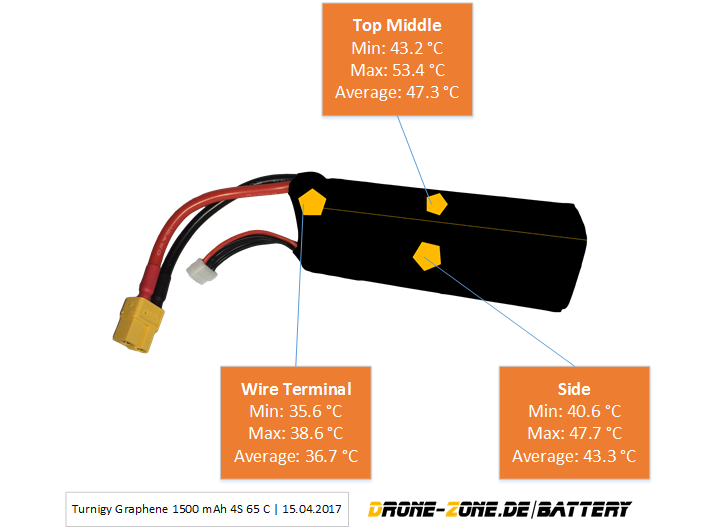
Temperature Development
Max. temp during discharge was around 53.4 °C on top of pack. Note that heating of stressed LiPo packs will continue for some more time even when load is cut.
Market Comparison
The following chart shows all reviewed LiPos in the same product segment for direct comparison of performance. Higher values under load are better.
Constant 25 C Discharge
Pretty much a standard benchmark in the LiPo industry.
Cut-Off /warning value for this battery should be chosen 3.5 V minimum. After this point voltage drops quick. The battery provided 1109 mAh (73,9 %) during the 25 C discharge.
Market Overview
Comparison of different reviewed 1500 mAh batteries under 25 C load.
Dynamic Load Testing
The dynamic load testing setting consists of two separate discharge scenarios that have been developed of two different real-life FPV flights. Pattern one represents a high speed low proximity flight around the open field with some hovering to the end. Average load is around 22 A. Second pattern is a free-style flight around trees in the park with some current spikes near 70 A. Average load on this flight is around 13 A due to longer floating periods.
Capacity Usage
During the test of pattern 1 the pack delivered 1120 mAh. This is 74.6 % of nominal capacity. Very good. In patter 2 testing 1158 mAh (74.7 %) could be used until first cell reached cut-off voltage.
Market Comparison
The following charts give an overview of all tested packs in the 1500 mAh class so far.
The last chart of this review sums up the usable capacity during all four load scenarios. Please note that this is only the capacity consumed by the electronic load! There are losses due to heating of the pack, which could be approximated (see testing methodology page). All four tests are cut when any cell goes below cut-off voltage of 3,3 V (or pack goes above 58 °C on any of the three probes).
If you would push further and go down to 3,0 V/cell you will be able to squeeze out some mAh more, but at the cost of excessive heat generation and shortening of pack life-span. This value will most likely differ from what you get when flying on a quad as most people don’t monitor voltage on a per cell basis and therefore don’t even notice if voltage drops below 3,3 V/cell during punsh-outs (what’s not necessarily a good thing, though). For comparison, used capacity until 3,3 V/cell is reached is the base line in all battery reviews on Drone-Zone.de.
Buy Turnigy Batteries on Amazon!*
Conclusion
The Turnigy Graphene 4S 1500 mAh 65 C battery* is a relatively large sized pack with a capacity to weight ratio of 7.17 mAh/g. It therefore is a notch heavier than the competition from Dinogy (Ultra Graphene 2.0). Build quality of this battery is excellent, as is the packaging the pack comes in. The pack is rectangular shaped and keeps it shape under every load situation. No puffing thanks to the metal sheets on both sides of the pack, which also help to spread heat across the outer cells. Most heat is dissipated through top and bottom, though. The mostly black design should optically fit almost any quad build. Voltage stability is good on the Turnigy Graphene 65 C pack*.
Cut-off should be chosen at 3,5 V / cell minimum. Usable battery capacity is good, but still behind the competition. Cell matching on our test sample is very good. The rating of 65 C still is a bit over the top, of course. I would rate this pack at very good 44 C continuous. This allows you to pull around 65.6 A continuous without having to worry about the packs health too much.
More than enough head room for most of the applications out there and in the top three of all testes packs in the 1500 mAh class so far. As you can see in the dynamic loads higher current spikes are handled well. Looking at the price tag, HobbyKing tries to position its Turnigy Graphene lineup as aggressively as possible. For only US-$ 28.50 you can get this battery directly at HobbyKing.
This means that the Turnigy Graphene lineup still is the cheapest option to get into graphene-enabled batteries. In the end this battery is able to push out high amps when needed for a very fair price tag. Just keep in mind that other brands (Dinogy*, Tattu) are doing equally good or better, when you are looking for the maximum of performance.
Buy Turnigy Batteries on Amazon!*
Other packs of this line up tested:



